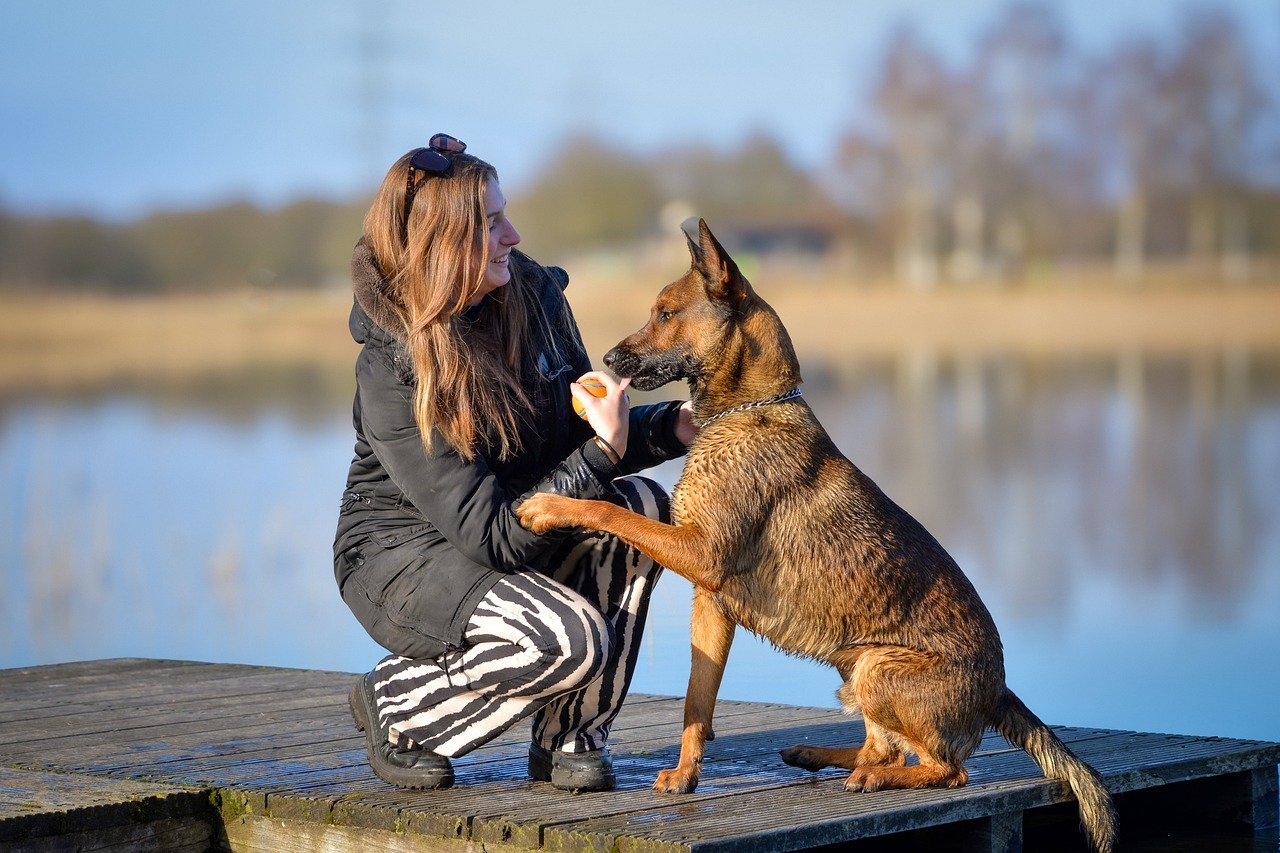Dogs have an almost magical ability to pick up on our moods—even before we realize how we’re feeling. Whether it’s a subtle shift in your voice, body language, or even scent, your pup is always tuned in. They can sense stress, sadness, excitement, and joy with remarkable accuracy, often reacting with comfort or playful energy to match your emotional state. In this article, we’ll explore 15 fascinating ways dogs read us like a book. It’s just one more reason why they truly earn the title of “man’s best friend.”
1. Reading Your Facial Expressions
Dogs are astonishingly good at reading human faces. They don’t just notice big smiles or frowns; they pick up on the tiniest twitches and changes in your eyebrows or mouth. When you’re upset, your dog may notice your eyes looking sad or your mouth tightening, even before you’ve spoken a word. This ability to interpret facial cues is a testament to how deeply attuned dogs are to their humans. Sometimes, a dog will mirror your expression, giving you a comforting look or even a gentle nuzzle. Their understanding goes beyond basic training—it’s a heartfelt connection that’s built over time. For many dog lovers, it’s almost like having a friend who speaks your emotional language without words. This silent communication is one reason why dogs make such amazing companions during both good times and bad.
2. Sensing Changes in Your Scent
With noses that are tens of thousands of times more sensitive than ours, dogs can detect incredibly subtle changes in your natural scent. When you’re stressed, anxious, or even excited, your body releases different hormones and chemicals. Dogs pick up on these scent cues, sometimes reacting before you even realize your mood has shifted. For example, if you’re nervous before a big meeting, your dog might become extra attentive or clingy. It’s as if your pup is tuned into an invisible radio station broadcasting your emotions. This keen sense of smell helps dogs offer comfort, calm, or even playful distraction exactly when you need it most. Isn’t it amazing how your dog’s nose can be the first to know how you’re truly feeling?
3. Listening to the Tone of Your Voice
Dogs may not understand every word you say, but they’re experts at picking up on the tone and rhythm of your voice. A cheerful, upbeat tone can make them wag their tails with joy, while a softer or shaky voice might make them approach you with concern. Even the slightest tremor or hesitation in your speech can alert your dog that something is up. This sensitivity to vocal cues often means your dog knows when you’re upset, stressed, or happy before you’ve made a conscious decision to show it. It’s like they have a built-in emotional radar, responding to your needs with a gentle lick or a playful bark. Next time your dog reacts to your voice, remember—they’re not just hearing you, they’re feeling you.
4. Picking Up on Body Language
Your dog is always watching you, taking in every gesture, posture, and movement. When you slump your shoulders or sigh deeply, your dog notices. If you move quickly and confidently, your dog may get excited and playful. On days when you’re dragging your feet or moving slowly, your dog might stay close or act more subdued. This ability to read body language is part instinct and part learned behavior. Over time, dogs learn what certain movements mean for their humans, adjusting their own actions to match. It’s an invisible dance, choreographed by years of living together and caring for each other. Your dog’s keen observation skills are one reason they make such attentive and empathetic companions.
5. Responding to Your Energy Levels

Dogs are masters at feeling the energy in a room. They sense when you’re full of excitement or when you’re drained after a tough day. Often, your dog will reflect your energy—bounding around when you’re happy or lying quietly beside you when you’re sad. This isn’t just coincidence; dogs have evolved to live closely with humans, adapting their behavior to fit our moods and energy. If you’ve ever noticed your dog acting unusually calm during your stressful times, it’s because they’re responding to the invisible signals you’re sending out. Their ability to tune into your energy is one of the many reasons why dogs are such comforting presences in our lives.
6. Detecting Heart Rate and Breathing Changes
Even without medical training, dogs seem to know when our bodies are reacting to stress or anxiety. They’re sensitive to changes in your breathing and heart rate. For example, if your breathing becomes shallow or your heart starts racing, your dog may become more alert or try to get your attention. Some dogs have even been trained to detect medical emergencies, like panic attacks or seizures, before they happen. But even without special training, most dogs naturally notice these physical changes and react with comforting behaviors. This ability can feel almost supernatural, but it’s really a combination of sharp senses and deep emotional intelligence.
7. Mirroring Your Emotions
Have you ever noticed your dog acting sad when you’re sad, or bursting with joy when you’re happy? Dogs often mirror the emotions of their humans, reflecting your mood right back at you. This empathetic behavior is a big part of why the bond between dogs and people feels so strong. When you’re down, your dog may curl up next to you, matching your mood with gentle, quiet companionship. During happy moments, your dog might jump, bark, or wag their tail as if celebrating with you. This emotional mirroring creates a powerful feedback loop of comfort and understanding—almost like having a living, breathing mood ring.
8. Reacting to Your Routine Changes

Dogs are creatures of habit, and any change in your daily routine can send them subtle signals about your mood. If you sleep in, skip your morning walk, or come home later than usual, your dog may sense something’s off. They’re incredibly quick to pick up on deviations from the norm, often responding with increased attention or concern. For example, if you’re feeling sick or sad and stay in bed longer, your dog might stay by your side or act more protective. These small shifts in routine are like breadcrumbs, leading your dog to an understanding of your emotional state—sometimes before you’ve even noticed the change yourself.
9. Watching for Tears or Crying

One of the most touching ways dogs sense our emotions is how they respond to tears or crying. Many dog owners have stories of their pup gently licking away tears or resting their head on their lap during sad moments. Dogs don’t just see the tears—they sense the emotional weight behind them. The sound of crying, combined with changes in your scent and body language, sends a strong signal to your dog that you need comfort. Their instinct to offer support in these moments is both heartwarming and deeply comforting. It’s as if they’re saying, “I’m here for you, no matter what.”
10. Responding to Laughter and Joy

Just as dogs comfort us during sad times, they also share in our happiness. The sound of laughter, the sparkle in your eyes, or the spring in your step are all cues that your dog understands as signs of joy. Many dogs will become more playful, wag their tails, or even “smile” when their humans are happy. This shared joy isn’t just fun—it’s a way dogs bond with us, reinforcing the positive emotions we feel. If you’ve ever found your dog bouncing around the room during a family celebration, you’ve witnessed this contagious happiness in action.
11. Noticing When You’re Distracted or Preoccupied
Dogs can sense when your mind is elsewhere. If you’re lost in thought, anxious about something, or simply distracted, your dog may nudge you, bring you a toy, or sit quietly at your feet. They pick up on the lack of engagement, noticing when your attention isn’t fully on them or the present moment. For many dogs, these moments are cues to check in, offering a reminder to be mindful and present. It’s almost as if they’re saying, “Come back to me—let’s focus on now.” This gentle grounding is one of the many ways dogs help us reconnect with ourselves.
12. Reacting to Raised Voices or Arguments
Tense moments, like arguments or raised voices, don’t go unnoticed by dogs. Even if the disagreement isn’t directed at them, dogs often react to the tension with nervous behaviors—pacing, whining, or seeking comfort. They’re acutely aware of the emotional energy in the room, sometimes trying to intervene or distract you from the conflict. This response isn’t just about avoiding loud noises; it’s about their desire to restore harmony and peace. Dogs thrive in calm, loving environments, and their reactions to arguments are a reminder of their sensitive, peace-loving nature.
13. Sensing Illness or Physical Discomfort
Beyond just emotions, dogs have an uncanny ability to notice when we’re not feeling well physically. They may sniff the area that hurts, stay close by your side, or act more protective. Some dogs have been known to detect illnesses like cancer, diabetes, or even migraines through scent and behavioral changes. Even without special training, many dogs will instinctively provide comfort during times of physical pain or sickness. Their watchful eyes and gentle presence can be a tremendous source of reassurance when you’re feeling vulnerable.
14. Picking Up on Hormonal Changes

Dogs are sensitive to the hormonal shifts in our bodies, whether from stress, pregnancy, or other life changes. These chemical changes can subtly alter your scent, which your dog detects almost instantly. Some dogs become more attentive or protective during pregnancy or when you’re experiencing hormonal ups and downs. It’s a quiet, invisible way they tune into your well-being, adjusting their behavior to offer support. This sensitivity to hormones is just another layer of their remarkable emotional intuition.
15. Anticipating Your Needs Before You Speak
Perhaps the most astonishing way dogs sense your mood is their ability to anticipate your needs, sometimes before you even ask. Whether it’s nudging you to take a break, offering a cuddle during stressful moments, or bringing you a favorite toy when you’re feeling blue, dogs often seem to know exactly what you need. This anticipatory behavior is a blend of observation, empathy, and deep love. It’s a reminder that dogs aren’t just pets—they’re intuitive, caring friends who walk beside us through every high and low.
It’s pretty amazing how dogs can read us so well—sometimes even better than we read ourselves! Their ability to sense our emotions is just one of the many reasons they make such loyal and comforting companions. By paying attention to their reactions, we can gain insight into our own moods too. The more we understand this emotional connection, the stronger our bond with them becomes. So next time your pup curls up beside you out of nowhere, trust—they probably know exactly what you need. What would life be like without these amazing, empathetic companions by our side?





